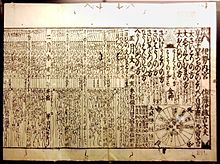Lunisolar calendar
A lunisolar calendar is a

Their months are based on the regular cycle of the Moon's phases. So lunisolar calendars are
Examples
The Chinese, Buddhist, Burmese, Assyrian,
Chinese lunisolar calendar
The
The traditional calendar calendars used the sexagenary cycle-based ganzhi system's mathematically repeating cycles of Heavenly Stems and Earthly Branches.[citation needed] Together with astronomical, horological, and phenological observations, definitions, measurements, and predictions of years, months, and days were refined. Astronomical phenomena and calculations emphasized especially the efforts to mathematically correlate the solar and lunar cycles from the perspective of the earth,[citation needed] which however are known to require some degree of numeric approximation or compromise.
The earliest record of the Chinese lunisolar calendar was in the Zhou dynasty (1050 BC – 771 BC, around 3000 years ago.[2] Throughout history, the Chinese lunisolar calendar had many variations and evolved with different dynasties with increasing accuracy, including the "six ancient calendars" in the Warring States period, the Qin calendar in the Qin dynasty, the Han calendar or the Taichu calendar in the Han dynasty and Tang dynasty, the Shoushi calendar in the Yuan dynasty, and the Daming calendar in the Ming dynasty, etc. Starting in 1912, the solar calendar is used together with the lunar calendar in China.
The most celebrated Chinese holidays, such as
The
Reconciling lunar and solar cycles
Determining leap months
This section needs additional citations for verification. (July 2021) |
A
Intercalation of leap months is frequently controlled by the "
The Buddhist and Hebrew calendars restrict the leap month to a single month of the year;[
With uncounted time
An alternative way of dealing with the fact that a solar year does not contain an integer number of
List of lunisolar calendars
The following is a list of lunisolar calendars sorted by family.
- Babylonian calendar family – common use of the Metonic cycle
- Ancient Macedonian calendar
- Hebrew calendar
- Umma calendar
- Hindu calendar family – shared astronomical roots
- Chinese calendar family – years start on second new moon after winter solstice (save for leaps)
- Unclassified or independent
See also
- List of calendars
- Callippic cycle
- Calendar reform
- Nasi'
- Other non-solar calendars
- Roman calendar (probably a lunisolar calendar with common years of 355 days and leap years of 378 days.)
- Rune calendar
- Tamil calendar
Notes
- ^ The modern Hebrew calendar, since it is based on rules rather than observations, does not exactly track the tropical year, and in fact the average Hebrew year of about 365.2468 days is intermediate between the tropical year (about 365.2422 days) and the sidereal year (about 365.2564 days).
References
- ^ F.C. De Blois, "TAʾRĪKH": I.1.iv. "Pre-Islamic and agricultural calendars of the Arabian peninsula", The Encyclopaedia of Islam, 2nd edition, X:260.
- ^ Xu, Zhaofeng. "Considering Chengzhou ("Completion of Zhou") and Wangcheng ("City of the King")" (PDF). Chinese Achaeology. 8: 172–177. Archived from the original (PDF) on 2015-07-22. Retrieved 2023-09-20.
- ISBN 978-1-891389-85-6.
- ^ P. Kenneth Seidelmann, ed. (1992). Explanatory Supplement to the Astronomical Almanac. p. 577.
For convenience, it is common to speak of a lunar year of twelve synodic months, or 354.36707 days.
(which gives a mean synodic month as 29.53059 days or 29 days 12 hours 44 minutes and 3 seconds) - ^ van Gent, R.H. (July 2021). "The Babylonian Calendar". Utrecht University.
- ^ Nilsson, Martin P. (1920), "Calendar Regulation 1. The Intercalation", Primitive Time-Reckoning: A Study in the Origins and First Development of the Art of Counting Time among the Primitive and Early Culture Peoples, Lund: C. W. K. Gleerup, p. 240,
The Lower Thompson Indians in British Columbia counted up to ten or sometimes eleven months, the remainder of the year being called the autumn or late fall. This indefinite period of unnamed months enabled them to bring the lunar and solar year into harmony.
- ^ Suttles, Wayne P. Musqueam Reference Grammar, UBC Press, 2004, p. 517.
Further reading
- ISBN 9780521885409.
External links
- Introduction to Calendars Archived 2019-06-13 at the Wayback Machine, US Naval Observatory, Astronomical Applications Department.
- Luni-Solar Calendar

